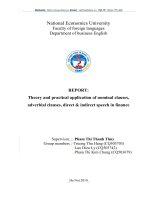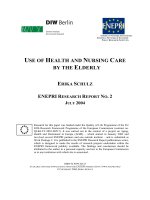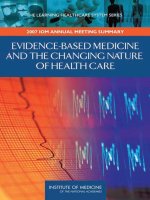Capacity and practical skill of health statistical staff and training needs
Bạn đang xem bản rút gọn của tài liệu. Xem và tải ngay bản đầy đủ của tài liệu tại đây (404.61 KB, 12 trang )
JOURNAL OF MEDICAL RESEARCH
CAPACITY AND PRACTICAL SKILL OF HEALTH
STATISTICAL STAFF AND TRAINING NEEDS
Nguyen Phuong Hoa¹, Pham Ngan Giang¹,
Thanh Ngoc Tien¹, Hoang Thanh Huong²
¹Department of Family Medicine, Hanoi Medical University; ² Ministry of Health
Objectives of the study were to assess the capacity and practical skills of the health statistical staff along
with their training needs. A cross-sectional study was conducted in health facilities of 3 provinces Ha
Nam, Bac Giang, Bac Ninh divided into three levels: province, district and commune. 104 health statistical
staffs completed questionnaires. The results indicated that human resource for the health management
information system was at low qualification. Only 29% of statistical staffs had graduation or post – graduate education, especially, the rate of personnel trained in statistic was very low (2.9%). The majority of
staffs did the statistical activities as part-time job and the average number of years working in statistical
field was 6. The capacity to use ICT for reporting and storing data was quite low at 12.4% and 7.9%
respectively. The capacity to analyze and use statistical data was poor, only less than 20% of total considered themselves “good” at data accuracy checking and interpreting the result. Only 35.6 % of health
staffs were able to interpret charts and a negligible amount of people could infer the reason of those
findings. In conclusion, it is important to provide new and qualified human resources and there is a large
need for training the existing staff in order to improve the performance of the health statistical information.
Keywords: health information, health statistical staff, training needs
I. INTRODUCTION
According to the UN Agencies framework [1], adopted by the Vietnam Ministry of
Health (MOH) [2], information is one important component of the health system and
plays a vital role in the development process of the health system. Complete, timely,
accurate and well-analyzed information not
only meets the needs of management and
Corresponding author: Nguyen Phuong Hoa, Department of Family Medicine, Hanoi Medical University
Email:
Received: 05 June 2017
Accepted: 16 November 2017
JMR 111 E2 (2) - 2018
administration of the health sector, but also
those of scientific research activities, policy
formulation and communication on healthcare for the population. The health information system consists of six components:
resources, indicators, data sources; management data; information product, dissemination, and use of information [3]. Among
those components, human resource development is the utmost importance [4 - 6].
Until 2012, in Vietnam, although there
were a number of policies from the government related to health statistics and infor95
JOURNAL OF MEDICAL RESEARCH
mational activities, but so far there was no
official document, that defines the health
statistics professional career, including the
training requirements for statistics staff.
Therefore, competency levels of health statistical personnel were also not assessed.
This was compounded by there not yet
having a plan for human resources development in the health sector in Vietnam. In
order to improve better capacity, it is essential to develop a detailed training program.
Hence, to build capacity for health statistical
staff, there should be specific assessments
of their practical skills, qualification, and
training needs [7; 8].
Based on the above reasons, this study
was conducted with the aim to assess the
capacity and practical skills of health statistical staff, and their training needs at provincial, district and commune levels
II. SUBJECTS AND METHODS
1. Subjects
Health statistical staffs who worked in
provincial, district and commune levels
were selected.
2. Methods
Locations
This study took place in 2012 at health
facilities of three provinces Ha Nam, Bac
Giang and Bac Ninh. Each province was divided into three levels:
- At Provincial level: staffs from the Department of Health, Provincial General
Hospital, Specialized hospitals, Provincial
Preventive Medicine Centers, Reproductive
Health Centre, and the HIV/AIDS Centre of
these provinces.
96
- At District level: staff from the District
Preventive Medicine Centres and District
Hospitals out of 5 districts per each province. 5 districts were selected by the simple
random method.
- At Commune level: staff from random
5 CHCs out of each district selected. Therefore, the total number of CHCs selected in
each province was: 5CHCs x 5 districts =
25 CHCs.
Size of the sample
There were a total of 104 respondents
- At Provincial level:
+ In each Department of Health (DOH) 3
officers were selected: 2 statistical officers
and 1 planning officer.
+ In the Provincial General Hospital, or
specialized hospitals and other health centres at provincial level, 2 officers were selected (1 statistical officer, and 1 planning
officer).
- At District level:
+ 3 people were selected at the District
Health Centre (one general statistics staff;
one reproductive health statistics staff; and
one planning staff).
+ At District Hospital: 01 statistical officer
and 1 planning officer were selected.
- At Commune/ ward level: only one person of each facility(the CHC/CHS heads)
was selected to answer the questionnaire.
Study design
Cross-sectional survey using self – administered mail questionnaire.
Data collection
This survey used a structured questionnaire.
Self-administered questionnaire was
used to collect the information on general
JMR 111 E2 (2) - 2018
JOURNAL OF MEDICAL RESEARCH
demographic characteristics, qualifications;
capacity in collecting, aggregating data, and
using information; and self-perceived training needs of staff doing statistical works and
planning in health facilities.
Health staffs participating in this survey
would complete the questionnaires under
the direct supervision of the researchers.
Data processing
STATA software was used for processing data. The assessment of the capacity of
analysing and using data ranged from 0%
(“Incapable”) to 100% (“most capable”). For
convenience, we subdivided the percentages into four different groups: a group of people with “weak” capacity (ranging from 0%
to 30%); a group “average” capacity (40%
- 60%); a group with “pretty good” (70% 80%) capacity, and a group with “good”
(90% - 100%) capacity.
Regarding the assessment of statistical
capacities related to health information, the
respondents were observed and scored
using some basic queries related to data
analysis. To analyze capacities related to
specific statistical methods, scores were
given to each respondent based on correct
responses to statistical problems.
3. Ethics
regarding the objectives of this assessment
and the detail of collecting information. Respondents completed autonomy in regard
to participation, as well as were freedom to
withdraw at any stage during the interview.
The collected data were used only for the
purpose of research.
III. RESULTS
Human resources
Table 1 describes the demographic
characteristics and qualifications of statistical staffs in our sample. In general, the statistical staffs were mostly over 50 years old
(44.2%). The higher the level of the facility,
the older personnels were. For example,
the province level had the highest number
of aged staffs, accounting for 67.5%. There
was a reversed age model at commune level with the officers over 50 years old only
accounting for 9.5% of the total, while the
highest pecentage belonged to the group
of staffs from 30 to 50 years old (47.6%). In
term of gender, although the distribution of
male and female in provincial facilities were
quite balanced, the overall pattern leaned
toward female of (72.1%), mostly due to
the big gap at the level of commune where
97.6% of workforce were female.
Respondents of this study all information
JMR 111 E2 (2) - 2018
97
JOURNAL OF MEDICAL RESEARCH
Table1. General information of the statistic personnel
Province
(n=43)
(%)
District
(n=19)
(%)
Commune
(n=42)
(%)
All locations
(n=104)
(%)
< 30
9.2
10.5
42.9
23.1
30 - 50
23.3
21.1
47.6
32.7
50+
67.5
68.4
9.5
44.2
Male
46.1
40.8
2.4
27.9
Female
53.9
59.2
97.6
72.1
Statistics
4.7
5.3
0
2.9
IT-ICT
7.0
5.3
0
3.9
Med/Pharm
32.6
26.2
0
18.3
Pub.Health
7.0
5.3
0
3.9
Middle or Secondary School
48.7
57.9
100
71.0
Full time
46.5
36.8
0
26.0
Part time
53.5
63.2
100
74.0
Characteristic
Age group
Sex
Education
Working time
In provincial facilities, there was 51.3%
of staff having graduate and post-graduate
education. However, out of the 43 people,
only 4.7% of them had graduated in statistics and only 7.0 % in ICT disciplines. Furthermore, all other locations had more than
50% of their statistical officers with middle or
secondary level qualifications. For instance,
the district health facilities had 57.9%; at
commune level, this rate was 100%. Therefore, the officers specifically competent in
managing the statistics and information
workload were very, very few. Overall, the
98
proportion of staff having middle-level education was high, about 71.0%, while the
amount of staff specializing in statistics was
critically low (2.9%). Another aspect of human resources is working time. There was
no level of health facility having over 50%
of the statistical staffs working full-time. The
most optimistic circumstance came from
the provincial facilities, where 46.5% of their
statistical officers did statistical activities as
their main daily work. The overall survey results showed that 74.0% of 104 statistical
officers responding to the questionnaires
JMR 111 E2 (2) - 2018
JOURNAL OF MEDICAL RESEARCH
were part-time mainly due to the absolute
rate of part-time staff at the commune level.
In terms of experience in health statistics calculated by years, the average
number was 6. For more detail, the rate of
three dimensions of experience, including
≤ 4 years, 5 - 10 years, over 10 years of
experience were 54.2%, 30.1%, 15.7%, respectively. This showed high staff turnover
in health statistics.
Staff performance features
Figure 1 illustrates influencing factors on
the quality of statistical reports, in the primary health care system. Statistics showed
personnel had compromising their work
awareness of several critical factors which
were ranked as followings: insufficient and
unstable workforce with 64.5% of respondent agreeing that high percentages came
from lack of supervision, untrained staff
and too many forms accounting for 56.5%,
50.2% and 46.3% respectively.
64.5
70
60
56.5
50.2
50
46.3
40
30
22.5
20
19.5
7.8
10
13.5
5.1
0
Figure 1. Influencing factors on the quality of reports
Capacity of using ICT
Figure 2 shows the situation and use of
ICT in health information system concerning
data processing and software applications.
There was a very high proportion (94.3%)
of officers who used a computer to process
data, while only 5.7% recorded data manually. With respect to data processing software, 70.3% of statistics personnel used
JMR 111 E2 (2) - 2018
MS Access-based software and 60.7% of
staff used software for statistical reports.
Pertaining to the way of reporting data,
most of respondents said they sent their
reports by post, only 7.3% sent reports via
emails, and only 5.1% used web-based reporting. Further investigation suggest the
situation of report submission and data ar99
JOURNAL OF MEDICAL RESEARCH
chive of CHC: reports were mainly in hard
copies, (74.3%) followed by reporting via
official government email system accounted at 5.89%; while via personal emails
was 22.87%. Furthermore, data archive
of statistical and planning personnel was
predominantly paper based, approximat-
ing 80%. About 70% of the total staff stored
data on personal computers. Server-based
archive only accounted for 7.9%. There
were 96.18% of CHCs storing data on paper, and of those, 22.8% also stored data on
their personal computers.
Figure 2. Capacity of using software for processing, transfering and storing data
Capacity of analyzing and using data
The survey team requested the statistics personnels to report on their self-perceived capacity to conduct several type of data analysis. The findings are presented in Table 2.
Table 2. Self assessment of capacity of analysing and using data
Statement
0 - 30% 40 - 60%
(Weak) (average)
70 - 80%
90 - 100%
(fairly
(good)
good)
Mean
SD
Check out data accuracy
4.9
38.8
36.9
19.4
67.0
17.7
Calculate percentage
3.9
30.1
31.1
35.9
72.1
18.3
Plot data by months or years
9.9
39.6
23.8
26.7
64.5
22.8
Analyze trends from bar charts
15.5
33.0
35.9
15.5
60.0
24.1
Interpret the data and their implications
11.8
37.3
32.4
18.6
61.2
24.1
Use data for cost estimation
3.9
25.5
40.2
30.4
71.7
18.2
Use data in planning
8.9
34.7
33.7
22.8
65.8
20.4
100
JMR 111 E2 (2) - 2018
JOURNAL OF MEDICAL RESEARCH
Capacity of analyzing and using
health statistical data
The results were not encouraging. Many
respondents were not able to indicate the
reasons for data collection, not able to describe ways of assessing the data quality
not able to list activities for removing the
causes of the poor data quality. In fact, the
mean of the respondents was below one
point in four out of six queries. Moreover,
the remaining two questions also received
similarly, low scores: the first question obtained a mean of 1.21 points, while the last
one had a mean of 1.20.
56.3% of staffs claimed that their capacity of checking data accuracy was “fairly
good” or “good”; more than 65% considered
themselves able to calculate percentages
for interpreting data and its implications;
and rates well or fairly well but less able to
plot data by months and years. More than
50% considered themselves able to calculate trends and interpret bar charts and the
same percentages; more than 70% considered themselves “fairly good” or “good” in
the use of the data for cost estimation; and
67% of the staffs “fairly good” at using data
for planning. These were maybe too optimistic results.
Table 3. Assessment on statistical capacities related to health information
Mean
SD
Max
≤ 1 score
(%)
Why collect data on diseases
1.21
0.74
3
62.4
Why collect data on immunization
0.91
0.74
3
78.9
Why collect population data by age groups
0.83
0.49
3
95.2
Listing at least 3 methods to check data quality
0.97
0.80
3
60.2
Defining not accurate data and their causes
0.10
0.33
1
99.0
Listing tentative activities to be implemented
1.20
0.89
10
69.2
Questions on
The overall percentage of correct calculations was 72.5%. Approx 71% were able to make
a bar chart. However only 35% of health staff were able to explain the chart findings, and less
than 10% of them were able to interpret the meaning of the chart.
Table 4. Assessment on capacity related to specific statistical examples and
calculations
Mean
SD
Max
0 score
(%)
≥ 1 score
(%)
Capacity of calculation
0.69
0.5
1
27.5
72.5
Plot data in a bar chart
0.71
0.46
1
28.9
71.1
Interpret findings from this bar chart
0.61
0.89
6
64.4
35.6
Statement
JMR 111 E2 (2) - 2018
101
JOURNAL OF MEDICAL RESEARCH
Infer the possible reasons for the results
of the example chart
Training needs
Most of the staff, 84.2 %, working on statistical information had not been trained. Out
of this total, the health workers at commune
level accounted for the highest percentages
of not trained, more than 90%. At the level of the province and district, the rates of
untrained staffs are lower, but still account
for relatively high percentages, 80% and
77.8% respectively.
Table 5 lists 11 training topics offered by
statistical personnel working on three levels
of health facilities. Among these numerous
demands of training, the basic statistics subject was the most needed, about 77%, and
also the highest proportions of demand at
all three levels. Next requested topics were
synthesizing report and data interpretation,
(60.4%) and using data for evaluation and
analysis (48%). Several topics with a rela-
0.09
0.28
1
91.4
8.6
tively high rate of request (> 40%) were statistics on morbidity and mortality by ICD10,
population statistics or using software for
data management and reporting.
Noticeably, there were considerable differences between levels in some training
needs. In regard to population statistics
and health related statistics on socio-economic problems, commune health workers
requested to be trained at high rates (71.1%
and 65.9%, respectively), while officers at
higher levels (25%) didn’t pay as much attention to these issues. Reversedly, in three
areas as using data for evaluation, using
management software and evidence based
planning, statistical personnels in provincial
and district health facilities demanded remarkably more than their colleagues at the
commune level.
Table 5. Training needs recommended by staff
No
Training topics
Province
(n = 43)
District
(n = 19)
Commune All location
(n = 42)
(n=104)
1
Basic statistics
77.2
65.3
81.5
76.8
2
Population statistics related to
health
24.1
26.4
71.1
43.5
3
Statistics on morbidity and mortality by ICD10
44.6
35.9
50.8
45.5
4
Statistics and nutrition and lifestyles
14.1
13.7
42.1
25.3
5
Synthesizing report and data
interpretation
58.5
49.9
67.1
60.4
6
Statistics on workforce and health
services
37.9
24.4
59.1
44.0
102
JMR 111 E2 (2) - 2018
JOURNAL OF MEDICAL RESEARCH
7
Health related statistics on economics, society, and environment
25.1
18.2
65.9
40.3
8
Using data for evaluation and
analysis
67.3
45.1
28.4
47.5
9
Evidence based planning
57.8
41.5
25.6
41.8
39.6
39.9
31.2
36.3
58.0
47.3
23.7
42.2
10 Basic IT knowledge
11
Using management and reporting
software
IV. DISCUSSION
This study provides useful statistics to
assess thoroughly the current situation of
Vietnam's health information system, paticularly the practical capacity of statistical
staff at primary health facilities.
Situation of human resources
There was a reverse pattern in the age
of staff between commune level and the
higher level health facilities. While at province and district level, about two third of
statistic personnels were over 50 years old,
those at commune level were mostly young.
This finding was similar to some previous
reports [9; 10]. This could be explained
differences in the main daily tasks of the
workforce. While at the commune level, due
to lack of human resource, statictical staff
had to do other missions. It created the
demand of young people who were better
poised to accomplish all activities. On the
other hand, officers working in provincial or
district facilities professionally practiced statistical activities as their main task, so experienced staff were needed. This trend was
also similar to some previous studies [1;
11]. To some extent, the high rate of aging
statistical personnels may affect negatively the quality of health information reports.
JMR 111 E2 (2) - 2018
Many staffs of higher age working in statistics are not willing to improve their capacity
and are often committed to the outmoded
ways of collecting, analysing and reporting
information [11]. With increasing challenges
in the healthcare area, information relating
to health is increasingly complicated, and
if the statistical officers are not trained to
meet these demands, there will be a messy
meaningless pile of data.
In terms of sex, there was no significant
disparity between male and female at province and district level, but at the commune
level, very few males did statistical work.
This phenomenon may come from the mobilization of CHC/CHS staffs mentioned
above, where many are female officers.
In recent years,the qualification of staff
working on statistical information has improved but this process has been slow
[2]. Until now, the majority of the statistical
workforce (71%) only had middle or secondary school qualification, very few have
attended statistical training courses. Drastically, at commune level, there was not any
statistical personnel having graduate training and this influenced directly the quality
of the report due to insufficient professional
103
JOURNAL OF MEDICAL RESEARCH
capacity. Moreover, the number of statistical
experience years of our sample was quite
low, below 4 years. This is another negative
impact on the quality of their work. In order
to well perform, not only are education qualifications necessary, but also necessary
are the experience and skills in collecting
and processing data. Normally, staff having
many years of experience can acquire the
expertise to collect, process, analyse data.
Capacity of statistical workforce
Pertaining to the ability of using ICT,
similar to findings from some other authors,
this study found that despite the high rate
of computer and software usage for processing data, few individuals processed information through internet and web-based
reporting and data storing service [7; 11 13]. This limitation can be clarified by some
following reasons. According to the existing
regulations, leaders of health facilities must
duly sign and stamp all reports to guarantee
the legality of the document, consequently, reports sent by emails were not legally
accepted. In addition, only health facilities
signing up to Government Gateway System have Electronic mail boxes, the rate
of those still now only accounts for 10.6%,
resulting in the low use of internet for reporting statistic data [3]. Moreover, the majority
of aged staffs as discussed above struggled
to learn how to use the internet, especially
the online applications.
With regards to the capacity of analysing and using data, about two third of respondents self-assessed to be fairly good
or good at almost all types of data analysis
and use. This was an overestimation. Why
staff filling in the questionnaires themselves
104
may mark higher may be due to their fear of
being judged as not capable, a risk to their
promotion, more alarming was when approx
60% of respondents scored below 1 point in
queries on health statistical data. Moreover,
when the practical skills of respondents
were tested by concrete problem, in spite of
favorable self-assessments more than 60%
of participants weren’t able to explain the
findings and few people could interpret the
chart they had just drawn. As seen, the statistical staff were still weak at data interpretation [11; 13]. It is supposed that the health
statistical information had not been applied
effectively and comprehensively, therefore,
the meanings of these documents were not
paid much attention to. As a result, statistical
staff only imitate others’ experience to finish
the required reports without any willingness
to explore the data or improve themselves
in applying the findings effectively.
Training needs
A small proportion of staff working on
statistical field had been trained. This situation is similar findings in some previous
surveys [1; 4; 11]. From above discussed
shortcomings, it is really urgent to focus on
training of health statistical staff. To make
this step effective, training should begin at
the most practical demands. A lot of topics
were listed. However, training basic statistics was the most wanted, then followings
were topics on data interpretation, synthesizing report and skill to use ICT. Similar
recommendation were also stated in several other studies [7; 14]. On further analysis each level, there was a discrepancy in
priority need between commune level and
higher level facilities. As discussed above,
JMR 111 E2 (2) - 2018
JOURNAL OF MEDICAL RESEARCH
at provincal and district level, statistical officers did their job professionally, as their
mission was to supply general statistical information to establish governmental plans,
to build up a national strategy, and to figure
out other macroscopic orientations. Consequently, they needed to be trained more
specifically in statistic activities such as
data interpretion, evaluation, and analysis.
On the other hand, at the commune level, the Population Officers (Collaborators)
were included in the CHC staff, therefore
the CHC took the charge of this duty. CHCs
need population data for the planning of
health services provision, such as immunisation services, reproductive health care,
health care for children and old people, etc.
That is why, compared with provincial and
district facilities, the demand of training in
areas relating to population and socio-economic issues were higher at the commune
level [4; 5].
V. CONCLUSION
The situation of the health statistical
personnel was severely unsatisfactory.
This survey describes in detail some of the
biggest problems affecting the HIS performance and the dissemination of timely, reliable information for users and citizens. The
results of the survey pointed out a critical
situation and several problems about the
human resources and their capacity, especially in the field of health statistic. The priority solution for this is to implement training
courses which meet the needs of each level
of health facilities.
Acknowledgements
JMR 111 E2 (2) - 2018
We would like to appreciate the Provincial Health Departments of Ha Nam, Bac
Giang and Bac Ninh provinces for giving
their support during data collection process.
We greatly thank all staffs from health facilities for their enthusiastic participation in
our study.
REFERENCES
1. Shakerishvili, G. (2009). Building on
health systems frameworks for developing a common approach to health systems
strengthening. Prepared for the World Bank,
Global Fund to Fight AIDS, Tuberculosis
and Malaria, and GAVI Alliance, TechnicalWorkshop on Health Systems Strengthening, 25 - 27.
2. MOH (2010). Five-year Health Sector
Development Plan 2011 - 2015
3. WHO/HMN (2008). Framework and
Standards for Country Health Information
Systems.
4. Mutale, W., et al. (2013). Improving
health information systems for decision
making across five sub-Saharan African
countries: Implementation strategies from
the African Health Initiative. BMC Health
Services Research, 13(Suppl 2), S9 - S9.
5. Nahm, E.S., et al. (2007). Outcomes
assessment of clinical information system
implementation: a practical guide. Nurs
Outlook, 55(6), 282 - 288.
6. Obembe T.A., O.K.O., Olumide E.A.
et al. (2014). Staffing situation of primary
health care facilities in Federal Capital Territory, Nigeria: implication for attraction and
retention policies. Am. J. Soc. Mgmt. Sci,
5(2).
105
JOURNAL OF MEDICAL RESEARCH
7. Rahimi, B. and V. Vimarlund (2007).
Methods to evaluate health information systems in healthcare settings: a literature review. J Med Syst, 31(5), 397 - 432.
8. Lippeveld, T., R. Sauerborn, and
S. Sapirie (1997). Health information systems-making them work. World Health Forum, 18(2), 176 - 184.
9. MOH-DPs (2012), Joint Annual Health
Review 2012, www. jahr.org.
10. Moazzam Ali, Y.H. (2002). Situation
analysis of health management information
system in Pakistan Pakistan. J.Med. Res,
41(2).
106
11. Nguyen Thi Tinh, N.T.H., Josie B.
Perez (2017). Report on Capacity Building
for Vietnam's HMIS.
12. WHO/HMN (2007). Assessment Tool
Guidelines, version 2.0.
13. MOH, D., HS Division (2006), Vietnam Health Information System Review
and Assessment.
14. Talat Mehmood, T.A., Syed Fawad
Mashhadi et al. (2011). Health management information system in district health
care. Pakistan Armed Forces Medical Journal, 61(4).
JMR 111 E2 (2) - 2018









